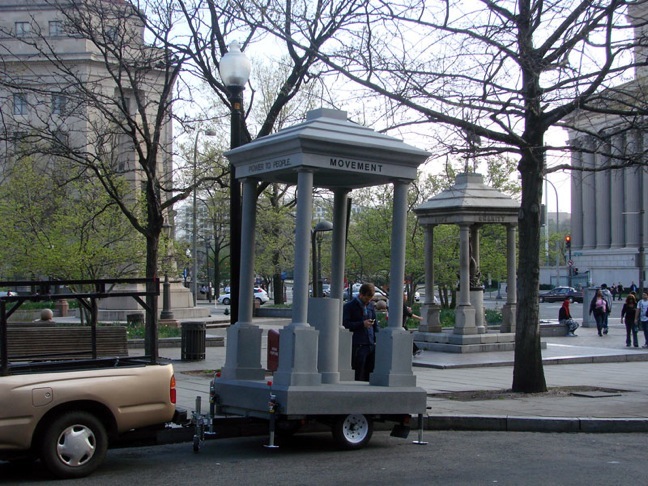DC Public
A hundred years ago, the mayor of Tokyo gave 3,000 cherry trees to Washington D.C., and a colorful tradition was borne: the National Cherry Blossom Festival. This past weekend marked the centennial of the gift, and a year since Japan was hit with a devastating tsunami. “5×5,” initiated by the D.C. Commission on the Arts & Humanities, asks five curators—Amy Lipton, Justine Topfer, Laura Roulet, Steve Rowell and Richard Hollinshead—to select five international artists who create temporary site-specific works throughout the city’s eight wards in vacant or dormant spaces.
On any given day, the National Mall is peppered with demonstrators championing various causes, while holdouts from the Occupy movement can still be found voicing their message. It’s not surprising then, that many of the 25 installations—up through April—reference protest and political activism. Berlin artist group KUNSTrePUBLIK replicated a version of the Temperance Fountain, complete with a working fountain and equipped with a microphone and speakers, to act as a portable “protest vehicle” for anyone’s use. “We created this sculpture to be adaptable to the different needs of the area communities to make a better life,” described the collective’s Philip Horst. This weekend alone they brought it to a party where Fugazi singer and straightedge pioneer Ian MacKaye explored ideas of how best to use it for change, and later, many saw it as a memorial when it was brought to a vigil for slain Florida teenager Trayvon Martin. With Polygonal Address (PA) System, Chicago-based artists Deborah Stratman and Steven Badgett produced an homage to activist Abbie Hoffman who, during the Vietnam War, marched on Washington intending to “levitate the pentagon to exorcise the evil spirits” using psychic powers. For their part, Stratman and Badgett built a solar-powered, rotating mini-pentagon that hovers above the waters behind the Titanic Memorial, broadcasting a range of historical sound recordings and political addresses.
For Cherry Blossom Cloud, Charles Juhasz-Alvarado fashioned a xylophone from cherry wood and invited the community to engage with the piece; and then there’s “Home Mender” by Monica Canilao, who drove cross-country with fellow collaborators collecting salvaged materials for a massive work in progress that spans the top floor of a building that once stored police evidence documents. “We came here to a completely empty room and built our own city,” Canilao described of the structure that they assembled to look like a woman’s legs; her torso turned into a small living room.
Most moving of all, however, is Office of Experiment’s 1×1 comprised of 1,000 small vials of “tears,” water collected in Japan after the earthquake. Visitors are encouraged to pour the water on a cherry tree bringing about a symbolic rebirth. This act also reflects what Tokyo’s mayor hoped to do a century ago: promote an international exchange between the two continents encouraging new life and friendships to blossom. As evidenced this weekend, the vibrant 5×5 project is the start of a new era of tradition.
FOR MORE INFORMATION ON THE 5×5 PUBLIC ART PROJECT, VISIT ITS WEBSITE.







